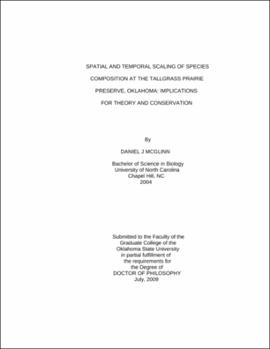| dc.contributor.advisor | Palmer, Michael W. | |
| dc.contributor.author | McGlinn, Daniel J. | |
| dc.date.accessioned | 2013-11-26T08:23:08Z | |
| dc.date.available | 2013-11-26T08:23:08Z | |
| dc.date.issued | 2009-07 | |
| dc.identifier.uri | https://hdl.handle.net/11244/6692 | |
| dc.description.abstract | Scope and Method of Study: The objective of this study was to advance our understanding of the drivers of species turnover using scaling relationships and patterns of species composition. To accomplish this objective I performed four studies in which: 1) I provided the meta-data for a long-term, multi-scale study on the vascular plants of a tallgrass prairie, 2) I developed a model of the species-time-area relationship (STAR) based on the sampling effect and compared it to an empirical STAR from a tallgrass prairie, 3) I tested if the rate of environmental and community distance decay were positively correlated in two habitat types, and 4) I quantified the importance of management-based heterogeneity relative to inherent sources of spatiotemporal heterogeneity on species richness and composition of a tallgrass prairie plant community over a period of 11 years. All four of these studies were based upon vegetation samples collected at the Tallgrass Prairie Preserve in Osage County, Oklahoma. Additional data were collected on soil cations and climate at the study site. Management records were provided by The Nature Conservancy who owned and managed the preserve. | |
| dc.description.abstract | Findings and Conclusions: I found that the sampling effect generated a STAR that was similar to the empirical relationship under certain conditions. Our model demonstrated that non-zero time-by-area interactions, which are the most important quantitative aspect of the STAR, are not necessarily attributable to ecological drivers and may result instead from a purely neutral sampling process. The geometry of the environment, as quantified by the rate of environmental distance decay, was positively correlated with the rate of species turnover in the grassland but not the woodland habitat. This suggests that one of the central tenets of the Environmental Texture Hypothesis is relevant at local spatial scales under certain conditions. Management had a significant but relatively unimportant influence of both species richness and composition of the tallgrass prairie plant community. Site effects were the most important source of heterogeneity, but year effects were comparable with respect to richness. The exact details of management may not be as critical for maintaining tallgrass prairie plant communities as long as woody plant encroachment is kept in check. | |
| dc.format | application/pdf | |
| dc.language | en_US | |
| dc.rights | Copyright is held by the author who has granted the Oklahoma State University Library the non-exclusive right to share this material in its institutional repository. Contact Digital Library Services at lib-dls@okstate.edu or 405-744-9161 for the permission policy on the use, reproduction or distribution of this material. | |
| dc.title | Spatial and temporal scaling of species composition at the Tallgrass Prairie Preserve, Oklahoma: Implications for theory and conservation | |
| dc.contributor.committeeMember | Fuhlendorf, Samuel D. | |
| dc.contributor.committeeMember | Steets, Janette A. | |
| dc.contributor.committeeMember | Tyrl, Ronald J. | |
| osu.filename | McGlinn_okstate_0664D_10364.pdf | |
| osu.accesstype | Open Access | |
| dc.type.genre | Dissertation | |
| dc.type.material | Text | |
| thesis.degree.discipline | Plant Ecology | |
| thesis.degree.grantor | Oklahoma State University | |
